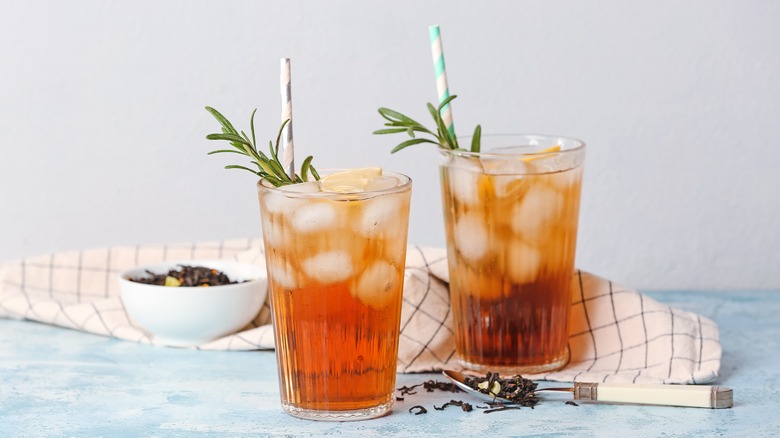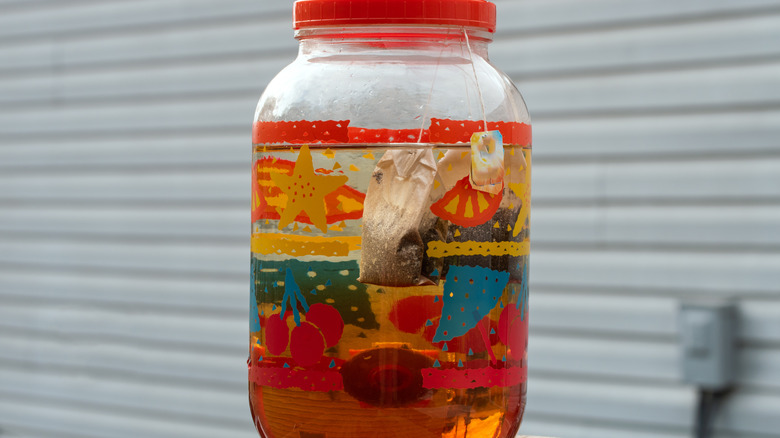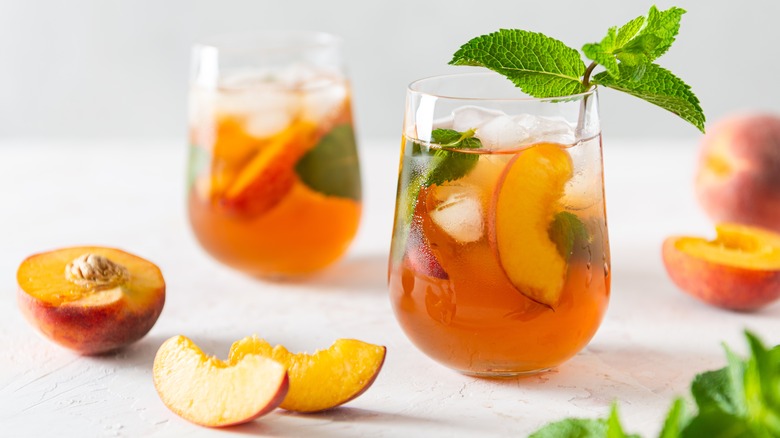The Mistakes You Should Avoid To Keep Home-Brewed Iced Tea Fresh
With its simple preparation and just a single ingredient besides water, home-brewed iced tea might seem like it could last forever. But, unfortunately, there are three common mistakes that can affect the beverage's freshness and increase the risk of making you sick if you drink it past its prime: choosing the wrong water source, the brewing method, and adding flavor ingredients to the pitcher.
Typically, iced tea has a shelf-life of up to three days, so it's best to only brew what you will consume within that timeframe to ensure your beverage remains fresh. If you'd like to flavor the drink with fruit, liquid sweeteners, dairy, or herbs, it's also key to avoid adding them to the entire batch because they will shorten the drink's shelf-life by providing an environment for bacteria to thrive. Instead, place add-ons like lemon wheels and sprigs of mint in individual serving cups that will be immediately enjoyed.
For lasting freshness, the way you store iced tea is important too. For home-brewed iced tea, keep it in a clean pitcher or jar in the refrigerator, and cover with a tight-fitting lid to prevent it from absorbing surrounding odors. If you're using a drink dispenser, ensure the spigot has been properly cleaned and disinfected daily so as to reduce the risk of contamination. Iced tea that looks or smells different should be dumped. Don't risk taking a sip to see if it's still fresh; just make a new batch.
How to safely brew iced tea
Iced tea can be brewed at home using several methods: cold brew, chilled hot brew, or the traditional sun-steeping method. Among these, steeping tea leaves in boiling water for three to five minutes is the safest method for preparing the drink. Because tea is minimally processed and has no preservatives, it can harbor bacteria like E. coli, which can cause foodborne illnesses. But you can kill any lingering germs by boiling the water it steeps in — just be sure the water reaches 195 degrees Fahrenheit to kill any bacteria, then store any leftovers in the fridge.
If you prefer a milder-tasting iced tea, cold brews are smoother, and require 12 hours to infuse in the refrigerator. Since they are prepared with cold water, it's advisable to rinse your tea with hot water before brewing, as the bag and/or leaves are not heat-treated to eliminate harmful bacteria. Furthermore, the Centers for Disease Control and Prevention (CDC) caution that iced tea made with well, spring, or mineral water might contain Cryptosporidium (Crypto) parasites, so try to always use filtered water as an option.
While making sun tea has a nostalgic charm, it may not be worth the health risk. To maintain food safety, prepared food must be stored at the correct temperature: hot food above 140 degrees Fahrenheit, and cold food below 40 degrees Fahrenheit. Sun tea typically reaches about 130 degrees Fahrenheit, placing it in "the danger zone," where bacteria can multiply rapidly, increasing the risk of foodborne illness.
Tips for the best-tasting iced tea
With only two ingredients to focus on, water and tea quality are crucial for this drink. Premium loose tea will provide the best-tasting drink. And even if it's safe to drink, tap water may contain trace amounts of algae and minerals, imparting sulfuric, metallic, or chlorinated tastes. Unfortunately, tea cannot mask these strong flavors, so for the best-tasting home-brewed drink, consider using bottled or filtered water.
Occasionally, tea brewed with boiling water or made with a tea bag left in it for too long will taste bitter. Like red wine, the drink develops tannins, which can leave your mouth feeling dry. To counteract the bitterness, consider adding a pinch of baking soda to make it smoother.
If you're a fan of fruity, sweetened tea, there are a few tips to liven up your next glass and reduce kitchen waste as well. Instead of scraping the dregs from a jam jar for your toast, use it to brew iced tea. Add a tea bag and boiling water to the empty glass jam jar, and allow it to steep for a few minutes before enjoying. If you're fond of refreshing watermelon, you can also use the rind to make iced tea. Boil the typically discarded green and white parts for a few minutes, and use the strained liquid to brew watermelon tea.



